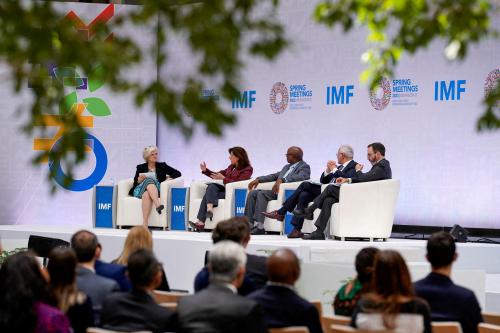For 40 years, the definition of Official Development Assistance (ODA) has served as the global standard for measuring donor efforts in supporting development cooperation goals. By documenting the volume and the terms of the concessional resources provided, assessing donor performance against their aid pledges and enabling partner countries, civil society, and others to hold donors to account, ODA has served as a widely accepted yardstick. Yet, based as it is on interpretation and consensus, the definition of ODA has always reflected a compromise. Under the oversight of the OECD’s Development Assistance Committee’s (DAC’s) statistical working party, the way ODA is defined has evolved over the decades. Until recently, the ODA definition has been based on principal developmental motivation and a degree of concessionality that reflects real donor effort.
In response to ongoing efforts to rethink ODA measurement and broader development finance, following is a letter from three former OECD/DAC chairs who worry that the basic role of the OECD/DAC in measurement is eroding.
Dear Chair,
We, former Chairs of the OECD/DAC or its statistical Working Party, are approaching you to express our concern about the direction of present efforts to “modernize” the measurement of ODA (Official Development Assistance) and broader development finance.
The “modernizing” effort now appears to be dominated by politically-motivated discussion guided by Finance Ministries. This is placing the clarity, integrity, and credibility of ODA statistics at risk. Finance Ministries’ main interest in the aid field is not to safeguard statistical integrity, but to reduce pressures to increase expenditure. Not unnaturally, they aim to get maximum ODA credit from a minimum of outlays, and it is therefore not surprising that their current dominance of the debate is leading towards overly “generous” proposed changes to reporting rules.
One concrete example is the ongoing discussion on how to reflect “private sector instruments” (PSI) in ODA. These instruments—including equity investments and guarantees by the official sector—are typically offered to private companies at or near market terms, so as to avoid distorting competition and spoiling markets. They thus fail one of the fundamental tests of ODA, which is that all its transactions must be “concessional in character;” in other words, they must reflect real government effort and give something of value away. In an attempt to circumvent this requirement, it is proposed, for PSI only, to replace the criterion of “concessionality in character” with the ill-defined notion of additionality. This means that ODA would mix two distinct quantities, thus creating systemic data inconsistencies.
Discarding concessionality as one of the pillars of the ODA definition contradicts its original purpose, which was precisely to distinguish between concessional and non-concessional flows. Including PSI as “ODA instruments” despite their lack of concessionality would blur the borderline between ODA (concessional) and other official flows (non-concessional OOF). This would undermine the basic architecture of OECD/DAC statistics, which distinguish four main categories of flows based on whether they are official or private, and concessional or non-concessional.
Moreover, the currently proposed parameters for including PSI in ODA would lead to further distortions:
- A suite of arbitrary and artificial discount rates have been proposed in order to generate “grant-equivalent” figures to be recorded as ODA for PSI transactions. Resulting amounts would bear no relation to the actual flows or to the benefits that receiving countries would obtain. Moreover, the political pressures to inflate ODA have led to unrealistically high proposed discount rates that lack credibility, especially in relation to equity investments.
- In an apparent recognition of the danger that the excessively generous new rules will encourage a stampede of donors towards “cost-free” ODA through PSI operations, it has been further proposed to set arbitrary caps on the share of ODA that can consist of PSI. But this would deprive ODA of its very nature as an objective statistical measure, since it would no longer comprise all and any transactions that met its definition, but would rather include an arbitrary basket of PSI transactions selected to fill up a predetermined quota.
- On the other hand, as a practical matter, the present volume of reportable PSI is small, and the complexity of proposed rules for reporting it is out of proportion to the amount of ODA generated. Each new instrument is going to require its own specific methodology for calculating a grant equivalent, and the burden of developing, understanding and correctly applying these methodologies is likely in practice to overwhelm both the Secretariat and members’ statistical correspondents. Moreover, the complex calculation machinery will produce ODA amounts that are completely non-transparent to users and beneficiaries.
We want to emphasize that we are not seeking to discourage the use of private sector instruments, which can indeed be important for development. Our objection is to scoring as ODA transactions that breach the principle that ODA must be concessional in character. We realize that in order not to discourage the use of PSI, providers must get credit for setting up systems that can offer this type of development finance. We are not against recording as ODA what passes the traditional test of ODA (including “concessional in character”), but the financial flows generated by private sector instruments themselves should be recorded in the OOF (other official flows) category. We are convinced that better visibility and recognition of OOF as important development finance, probably as part of the emerging TOSSD measure, is required in order to be able to forge a consensus of the DAC membership for such a solution.
Without going into more examples than PSI or technical detail at this point, we ask you to consider these concerns in the interest of preserving the acknowledged high standard of OECD/DAC statistical measurement. If the present excessive political influence on decision-making is not curbed, even the basic role of the OECD/DAC in measurement may well be questioned. Although this role has continued for nearly 60 years, the OECD/DAC holds no mandate for it from the United Nations, which alone has set the targets against which performance is being measured. If members continue to expand the coverage of ODA in ways that violate its basic concept and definition, we see a clear danger that the UN may in future bypass the OECD/DAC and institute its own measurement system.
We therefore urge that you not sacrifice practical feasibility, technical soundness and statistical integrity on the altar of a swift political consensus, and instead develop a more inclusive and professionally sound approach to revising ODA measurement. ODA figures need to be accepted by all—donors, beneficiary countries, other international organizations, researchers, NGOs and others—and in our view some system is needed that enables the OECD/DAC to engage with such groups when fundamental reforms are contemplated.
As for the ongoing DAC discussion on PSI, which has not been concluded as we understand, we realize that the search for solutions must deliver two answers: 1) a modus vivendi for current reporting (DAC Statistics must be able to present unbroken ODA time series) and 2) a permanent arrangement for PSI recording that is able to withstand scrutiny by all stakeholders. For item 2, our suggestion would be to take a step back, re-think and actually re-design the whole approach. This reengineering may take some time, therefore we would caution the DAC against letting the interim arrangement become “permanent” simply for lack of a political consensus or the satisfaction of a few donors with interim reporting rules.



Commentary
Don’t undermine the basic architecture of OECD/DAC statistics: A Letter of warning
December 21, 2018